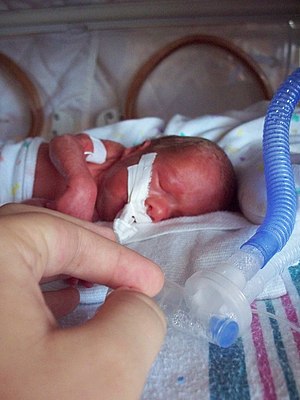Premature labor
| Preterm birth | |
|---|---|
 |
|
| Intubated preterm baby in an incubator | |
| Classification and external resources | |
| Specialty | Obstetrics, pediatrics |
| ICD-10 | O60.1, P07.3 |
| ICD-9-CM | 644, 765 |
| DiseasesDB | 10589 |
| MedlinePlus | 001562 |
| eMedicine | ped/1889 |
| MeSH | D047928 |
Preterm birth, also known as premature birth, is the birth of a baby at fewer than 37 weeks gestational age. These babies are known as preemies or premmies. Symptoms of preterm labor include uterine contractions which occur more often than every ten minutes or the leaking of fluid from the vagina. Premature infants are at greater risk for cerebral palsy, delays in development, hearing problems, and sight problems. These risks are greater the earlier a baby is born.
The cause of preterm birth is often not known. Risk factors include diabetes, high blood pressure, being pregnant with more than one baby, being either obese or underweight, a number of vaginal infections, tobacco smoking, and psychological stress, among others. It is recommended that labor not be medically induced before 39 weeks unless required for other medical reasons. The same recommendation applies to cesarean section. Medical reasons for early delivery include preeclampsia.
In those at risk, the hormone progesterone, if taken during pregnancy, may prevent preterm birth. Evidence does not support the usefulness of bed rest. It is estimated that at least 75% of preterm infants would survive with appropriate treatment. In women who might deliver between 24 and 37 weeks corticosteroids improve outcomes. A number of medications including nifedipine may delay delivery so that a mother can be moved to where more medical care is available and the corticosteroids have a greater chance to work. Once the baby is born care includes keeping the baby warm through skin to skin contact, supporting breastfeeding, treating infections, and supporting breathing.
...
Wikipedia
